Flying Tigers Blu-ray Movie
HomeFlying Tigers Blu-ray Movie 
Olive Films | 1942 | 102 min | Not rated | May 13, 2014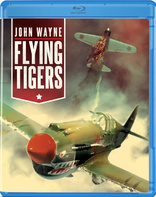
Movie rating
7 | / 10 |
Blu-ray rating
| Users | 0.0 | |
| Reviewer | 3.5 | |
| Overall | 3.5 |
Overview
Flying Tigers (1942)
Capt. Jim Gordon's command of the famed American mercenary fighter group in China is complicated by the recruitment of an old friend who is a reckless hotshot.
Starring: John Wayne, John Carroll (I), Anna Lee (I), Paul Kelly (I), Mae ClarkeDirector: David Miller (I)
| War | Uncertain |
| Drama | Uncertain |
| Action | Uncertain |
Specifications
Video
Video codec: MPEG-4 AVC
Video resolution: 1080p
Aspect ratio: 1.37:1
Original aspect ratio: 1.37:1
Audio
English: DTS-HD Master Audio Mono
Subtitles
None
Discs
25GB Blu-ray Disc
Single disc (1 BD)
Playback
Region A (locked)
Review
Rating summary
| Movie | 3.5 | |
| Video | 4.0 | |
| Audio | 3.5 | |
| Extras | 0.0 | |
| Overall | 3.5 |
Flying Tigers Blu-ray Movie Review
Would you dare to call John Wayne "Pappy"?
Reviewed by Jeffrey Kauffman May 14, 2014The United States’ official entry into World War II wasn’t even a year old yet when Flying Tigers premiered in October 1942, quickly becoming one of the year’s biggest hits and helping to set the template for what the coming years would provide in terms of war films—even though Flying Tigers was ironically not really about World War II. As legendary as the Flying Tigers have become over the years, at one point they were seen as a kind of bastard stepchild of authorized military forces, kind of an aviation themed sibling to the previous decade’s Abraham Lincoln Brigade. In both assemblages, volunteers ended up banding together to fight perceived threats as mercenaries, basically guns and/or pilots for hire. In the case of the Abraham Lincoln Brigade, many left leaning Americans and other nationalities matriculated to Spain to help the Communists (the good guys in this instance) fight the Fascists under the command of Franco. In the case of the particular battles depicted in Flying Tigers, it’s a mercenary air force stationed in China helping China’s then military leader Chang Kai-shek hold off the invading Japanese. Chang himself actually shows up as Flying Tigers begins, at least in a still photograph over which is superimposed a quote attributed to him thanking the Flying Tigers for helping to protect his homeland. The specifics of the conflict in Flying Tigers may not have been paramount on audiences’ minds when they saw the film, for on a baseline level it offered Japanese villains that filmgoers were probably thrilled to see shot down in probably intentionally bloody conflagrations. The fact that these particular Japanese were not involved in any actual World War II operations became secondary, and in a bit of probably easy transference, the gung ho Americans at the center of the film seemed to be fighting for everything those in the United States held dear, if only by default.
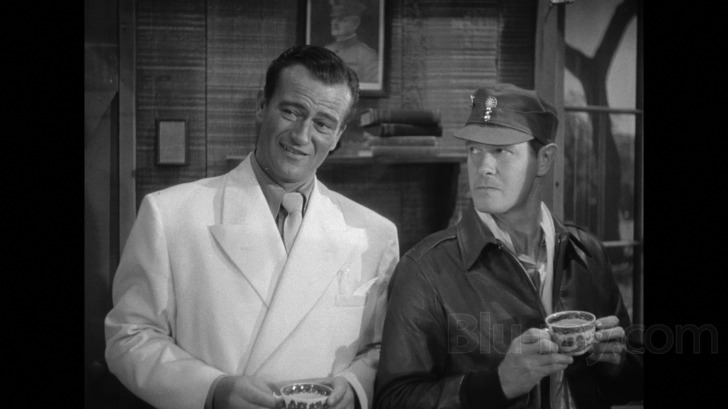
Many have debated whether or not President Franklin Delano Roosevelt actually had some kind of foreknowledge about the impending Japanese attacks on Pearl Harbor and chose to do nothing because he knew the shock of the attack would jolt Americans out of their isolationist policies. It’s sometimes forgotten that there was a lot of back and forth about whether the United States should get involved in World War II, long before it ultimately became the testing ground for the Greatest Generation. It’s out of this isolationist background that groups like the ALB and Flying Tigers arose, because there were individuals who were so deeply motivated by what they saw going on in the world that they simply couldn’t watch from the sidelines.
That kind of rah-rah activism was part of what made Flying Tigers so memorable. While some audience members may have been generalizing from the specific China-Japan battle outwards to the larger conflict that had consumed the United States since December 7, 1941, one way or the other there was a group of Americans out there getting the job done their way, in some cases, sacrificing their lives for the greater good. The fact that there was a little good old fashioned capitalism at work as well in the form of the pay these mercenaries received, Flying Tigers makes no secret about what it feels is the Americans' real motiviation for getting involved.
John Wayne portrays Jim "Pappy" Gordon, a resolute squadron leader who angrily mourns the loss of a kid in an early scene, but who has no trouble passing along the scarf of another deceased comrade to a new recruit later in the film. Jim is in love with pretty nurse Brooke Elliott (Anna Lee), a woman we know is completely noble and spunky because she first feeds, then saves, a gaggle of Chinese orphans in an early scene. Things get ostensibly more complex when Jim's old buddy Woody (John Carroll) shows up, eager to join Jim's group. Woody has a shaded past and an alcohol problem that's at least hinted at, and Jim is understandably concerned.
Flying Tigers doesn’t really tread any new ground in terms of story once the three principals are set in place. Woody of course joins Jim, causes some trouble and appears to have ambivalent motivations, but (no surprise here) goes all heroic as the film moves into its climax. Carroll is nicely oily but likable in the role, and certainly offers more flavor than either the stern but tamped down Wayne or the pretty but underutilized Lee. While certainly not at the level of The Blue Max, and especially considering this film’s Republic Studios imprimatur, the aerial sequences are generally quite well done. Director David Miller weaves together miniatures, stock footage, and rear projection to give some decently visceral accounts of some vicious air battles.
Flying Tigers Blu-ray Movie, Video Quality 
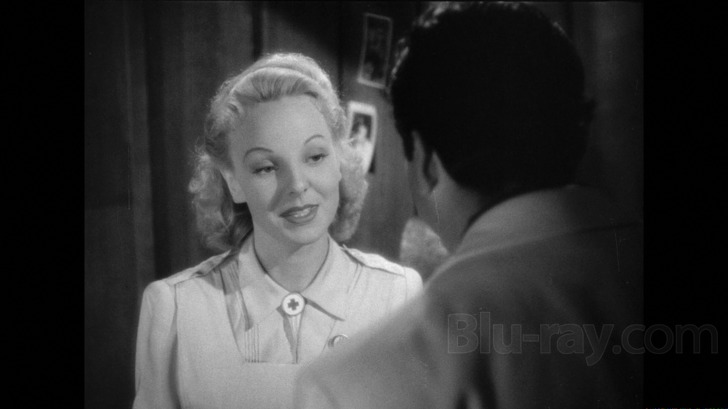
Things get off to a bumpy start with Flying Tigers' AVC encoded 1080p transfer in 1.37 (courtesy of Olive Films), but if you get past the disruptive takeoff, the rest of the flight is rather smooth. There's fairly bad damage, including obvious flicker and some really odd image instability, that afflicts just the first few opening shots after the credits. After that, things settle down, and while there is still understandable age related wear and tear to the elements, the image remains stable and features great contrast, with nicely modulated gray scale. Miller utilizes a lot of stock footage (he hilariously reuses a couple of clips), and some of that looks quite shoddy, with heavy scratching, tons of grain, and an almost blurry image. But the bulk of this transfer is surprisingly sharp and nicely organic looking, with no signs of obvious digital tweaking.
Flying Tigers Blu-ray Movie, Audio Quality 
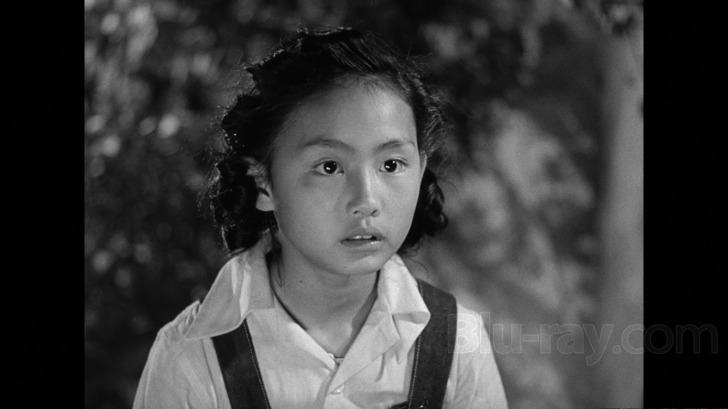
Flying Tigers' lossless DTS-HD Master Audio Mono mix can't quite overcome the limitations of its source stems, but aside from some passing distortion (audible in the opening Republic fanfare), things sound decent if not fantastic. In fact, there's actually some surprising low end on this track (listen to the reverberant noise of the aircraft flying through the valley late in the film for a great example). Dialogue and Victor Young's Oscar nominated music sound fine.
Flying Tigers Blu-ray Movie, Special Features and Extras 
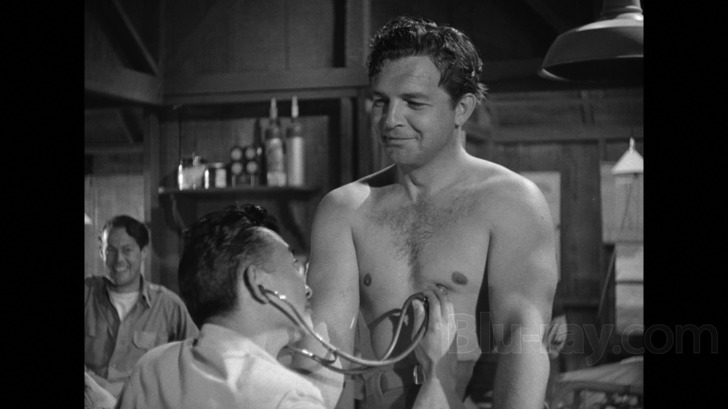
No supplements are offered on this Blu-ray disc.
Flying Tigers Blu-ray Movie, Overall Score and Recommendation 
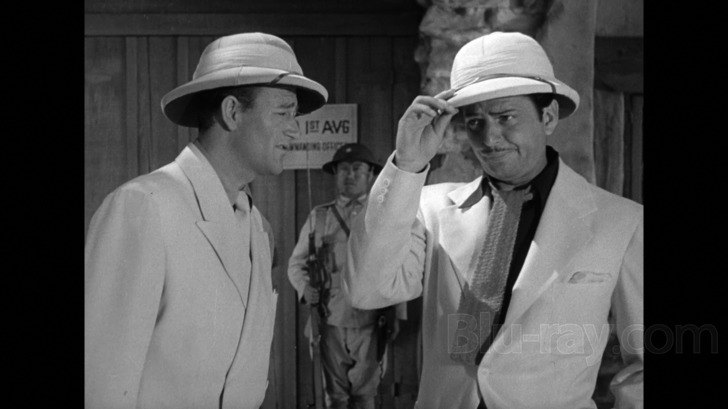
There's little doubt that Flying Tigers, while perhaps not ostensibly trying to "cash in" on the then "new" battle of World War II (at least insofar as the United States was concerned), still wasn't above trotting out some fairly propagandistic ideas, portraying the evil Japanese as power mad conquerors hell bent on destruction. In one of the curious footnotes to the film's historical (in)accuracy, it's actually one of the good guys who becomes a kamikaze pilot in the film's combustible climax. This was the first of many John Wayne war efforts, and if he can't quite compete with Carroll's colorfulness, he anchors the film with his patented, stolid, no nonsense way. This is a surprisingly good looking Olive release after a few troubling moments at the outset. Recommended.
Similar titles
Similar titles you might also like

Sands of Iwo Jima
4K Restoration
1949

They Were Expendable
Warner Archive Collection
1945

Twelve O'Clock High
1949

Never So Few
1959

Objective, Burma!
Warner Archive Collection
1945

Merrill's Marauders
Warner Archive Collection
1962

The Green Berets
1968

The Young Lions
Limited Edition to 3000 - SOLD OUT
1958

The Red Ball Express
1952

Run Silent, Run Deep
Special Edition
1958

The Dirty Dozen
1967

Greyhound
2020

Attack!
Fragile Fox
1956

The Bridge at Remagen
1969

The Fighting Seabees
1944

Wake Island
1942

The Eagle Has Landed
1976

633 Squadron
1964

The Blue Max
Limited Edition to 3000 - SOLD OUT
1966

Too Late the Hero
1970